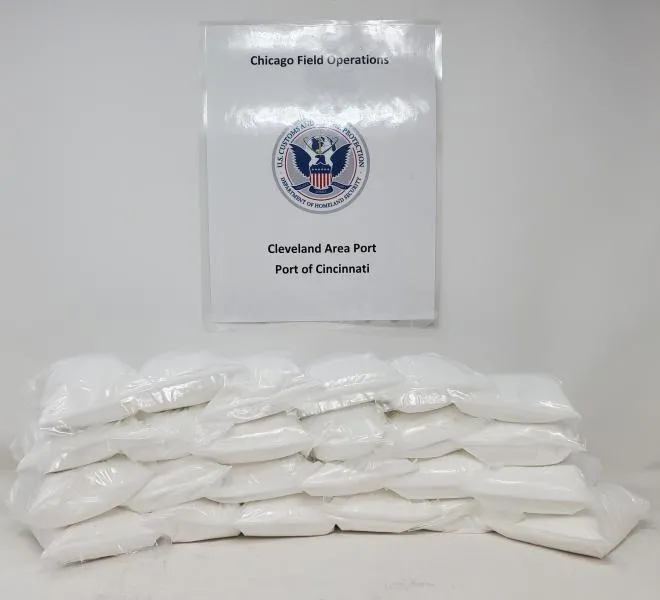CLEVELAND–The Area Port of Cleveland oversees major express consignment operations (ECO) in Indianapolis, Cincinnati, and Louisville. U.S. Customs and Border Protection (CBP) officers that work in these facilities seize illegal shipments nightly that are heading to every community in the U.S. and could harm our economy, our agricultural industry or cause death. CBP officers continue to be the first line of defense in stopping these dangerous shipments.

officers working at ECOs in Indianapolis, Cincinnati, and
Louisville.
In these past six months officers have been stopping a record number of shipments before they reach their finals destination. One of the main reasons for these increases is the rapid growth of e-commerce. Consumers can search for and easily purchase millions of products through online vendors, but this easy access gives illicit goods more ways to enter the U.S. economy.
Since October 1, CBP officers in Indianapolis have seen an increase across the board in drug seizures, counterfeit interceptions, and agricultural inspections. Officers at this ECO saw an increase of 117% in total seizures that were made in Indianapolis, inspecting, and seizing 738 shipments that contained popular drugs like marijuana, Ketamine, and prescription drugs.
Officers also intercepted 714 parcels of counterfeit items that if real their Manufacturer’s Retail Price (MSRP) would have been over $41.6 million. Last year at this time officers seized counterfeit items with a MSRP more than $13.1, a 216% increase. CBP officers in Indianapolis also were stopping pests and disease from entering the U.S. by issuing 497 Emergency Action Notifications (EAN). EAN can alert trade entities of non-compliance with Animal and Plant Health Inspection Services regulations. This year EAN issuance is 148% higher than it was this time last year.
Indianapolis was just one ECO. The other two ECO hubs in Cincinnati and Louisville have had similar increases. In Cincinnati, officers have seized 4,059 packages, a 70% increase from this time last year. Of those seizures 506 contained narcotics. The drugs of choice were marijuana, cocaine, and methamphetamine. In all officers seized 5,044 pounds of narcotics. Officers in a partnership with the Food and Drug Administration also seized 1,039 packages containing FDA unapproved items, a 79% increase from last year’s total.
Cincinnati CBP intercepted 771 parcels containing Intellectual Property Rights violations with a MSRP, if they were genuine, of $60.8 million. CBP Agriculture Specialists (CBPAS) in Cincinnati inspected 13,687 shipments resulting in 5,072 EAN, a 41% increase from this timeframe last year. CBPAS notable seizures so far are 132 pounds of smuggled pork, Bird’s Nest hidden in chip canisters and a parcel containing a dried duck carcass.
Louisville CBP takes home the title of most narcotic seizures and total pounds. CBP officers in Louisville have made an astonishing 1,472 seizures of narcotics at their facility. The most popular drugs seized were marijuana, methamphetamine, and steroids. In all, officers seized a whopping 10,436 pounds of narcotics. Of that, 235 pounds was fentanyl, enough to kill 50 million people. That is enough to kill the entire population of New York (8.8 million) six times. Louisville also made a splash seizing 1,311 IPR violations that would have been worth over $149.5 million (more than Indianapolis and Cincinnati combined) and issuing 5,824 EANs.
“These numbers represent the amount of illicit material that comes through these ECO hubs,” LaFonda D. Sutton-Burke, Director, Field Operations-Chicago Field Office, pointed out. “These environments that our officers work in and every day they are stopping shipments that are dangerous, harmful to our citizens.”
An ECO is a facility operating in any mode or intermodally moving cargo by special express commercial service under closely integrated administrative control. Under Title 19 of the Code of Federal Regulations, CBP officers are stationed at ECOs and other smaller hubs across the nation and work in collaboration with these carriers to stop illegal shipments. The partnership with the ECOs is critical in CBP accomplishing its mission.
“Our officers are highly skilled at identifying packages that represent a higher level of risk through visual examination, based on their knowledge and awareness of ever-changing trends employed by the individuals and organizations seeking to illegally import contraband,” said Diann Rodriguez, Area Port Director-Cleveland.
CBP’s border security mission is led at 328 ports of entry by CBP officers from the Office of Field Operations. Please visit CBP Ports of Entry to learn more about how CBP’s Office of Field Operations secures our nation’s borders. Learn more about CBP at www.CBP.gov.

